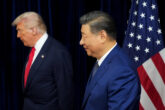March 11, 2022
What South Korea’s Election Means for Its Technology Alliance With the United States
Following months of bitter contest, South Koreans on Wednesday narrowly elected Yoon Suk-yeol, the candidate from the conservative People Power Party, as the country’s next president. Facing an uncertain economic outlook and increasing political polarization, the stakes of the election were momentous, with some comparing the ferocity of the campaign to the popular Korean horror-survival show “Squid Game.” In particular, Yoon came under fire for his stance against feminism, which resulted in him winning just 34 percent of the vote from women in their 20s.
In terms of foreign policy, Yoon is expected to take a more hawkish approach to China, and to pursue a renewed, strengthened alliance with the United States. Under Yoon’s presidency, for example, the United States is likely to resume bomber flights and carrier strike group deployments to the Korean Peninsula, which have been on pause since 2018. But Yoon’s election also presents opportunities to strengthen the South Korea-U.S. relationship beyond traditional security concerns. One of these is the promotion and protection of critical and emerging technologies.
Yoon’s election presents opportunities to strengthen the South Korea-U.S. relationship beyond traditional security concerns.
First, the Yoon administration can build on the work of its predecessor to strengthen South Korea-U.S. promotion of emerging technologies. The May 2021 summit between Presidents Moon Jae-in and Joe Biden established a framework under which the United States and South Korea can coordinate on high-technology issues, but it will be up to Yoon, who takes office in May, to put words into action. In artificial intelligence, for example, the United States and South Korea have both recognized the mutual benefit of exchanging scientific talent but have yet to establish a formal mechanism for doing so. Both countries also agreed to collaborate when screening outbound technology investments, but such screening mechanisms are still under negotiation in the United States and are not expected to crystallize until later this year.
Read the full article from The Diplomat.
More from CNAS
-
Transatlantic Security / Technology & National Security
Look Before We Leap on Artificial IntelligenceThis article was originally published on The Dispatch. A debate about the role that artificial intelligence should and will play in society, and how it will affect humanity fo...
By Jon B. Wolfsthal
-
Technology & National Security
Caleb Withers on the Cybersecurity Frontier in the Age of AICaleb Withers, research associate at the Center for a New American Security, joins Kevin Frazier, the AI Innovation and Law Fellow at the University of Texas School of Law and...
By Caleb Withers
-
Technology & National Security
Prepared, Not ParalyzedExecutive Summary The Trump administration has embraced a pro-innovation approach to artificial intelligence (AI) policy. Its AI Action Plan, released July 2025, underscores t...
By Janet Egan, Spencer Michaels & Caleb Withers
-
Indo-Pacific Security / Technology & National Security
Sharper: Tech + ChinaRecent talks between President Donald Trump and Chinese Communist Party General Secretary Xi Jinping placed a spotlight on emerging technologies, from high-end chips to minera...
By Charles Horn & Sevi Silvia




